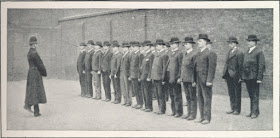In 1901, a journalist for Living London observed the Metropolitan Police Force at work. When referring to police constables, he wrote: "Any young man in possession of good health and character, between twenty-one and twenty-seven years of age and not less than 5 ft 9 in. in height, may apply for admission to the force; and, if preliminary inquiries prove satisfactory, he will be directed to attend at headquarters on a specified Tuesday. There, in company with some fifty other candidates, he must undergo a searching examination at the hands of the Chief Surgeon, and if pronounced physically fit for police duty will be further tested as to his general intelligence and his ability to read and to write well."
Afterwards, the budding constable was sent for three weeks as a 'candidate on probation' to the Candidates' Section House in Kennington Lane. While there, he was drilled twice daily in squad exercises by an instructor at Wellington Barracks, and also trained in the use of the ambulance. He was then sworn in as a constable "from which moment his career as a guardian of the public peace begins". He was then posted to fill a vacancy at one or other of the twenty-two divisions of the force.
 |
| 'Drilling Recruits (Wellington Barracks)' from Living London (1901) |
In 1901, a police constable's pay started at 25s. 6d. weekly, "rising a shilling annually to the modest limit of 33s. 6d." But if he was a efficient officer, a policeman like P.C. Bobby Grace could "rise through the grades of sergeant, station officer, and inspector to the rank of superintendent, at a salary of £400 a year." Along with his uniform, the police constable was given "an armlet, to be worn on the left sleeve when on duty, a whistle and chain, and a stout boxwood truncheon - his sole weapon of defence." By 1901, handcuffs were no longer carried unless some violent or dangerous offender was to be apprehended. The young officer was then sent to do eight hours' duty daily in the London streets, either in two terms of four hours each or in a single spell.
 |
| 'Going on Duty' from Living London (1901) |
The work was extremely varied with "disturbances to be quelled and crowds dispersed, doubtful characters to be watched and obstructive costermongers and street vendors to be 'moved on', endless questions to be answered and directions given; stray dogs to be seized, pickpockets, beggars, drunken persons, and other actual or suspected offenders to be arrested, besides innumerable minor breaches of the law to be reported."
The single men of each division were housed in the 'divisional section house', "a sort of police barracks, but roomy, well-appointed, and homely, as soldiers' quarters are not". For a subscription of six or seven shillings weekly, the constable was entitled to a comfortable bed in this building, a hot dinner or supper daily, and the use of the police library and common rooms. After his duty was over, "he amuses himself with billiards, chess, boxing, and gymnastics, or, if he prefers, can read or study for promotion undisturbed. There are cricket and football clubs in each division, a band for musical members of the force, a sick room and medical care for the suffering."
 |
| 'In a Section House: A Wrestling Bout' from Living London (1901) |
It will be interesting to see how far P.C. Bobby Grace progresses up the ranks - if he doesn't get killed off, that is!
Super stuff, thank you.
ReplyDeleteWhen Peel introduced the Peace of Preservation Act 1814 it created a Force that would not have been familiar in late Victorian times. So when did the police become responsible for preventing crime and protecting property? Clearly well before 1901 when your young police constables were learning their trade.
Thanks for your comment - glad you liked the post. I believe it was in the 1840s that the role of London police evolved into preventing crime, protecting property and maintaining public order. That was also when the Detective Branch was founded (1842).
ReplyDelete